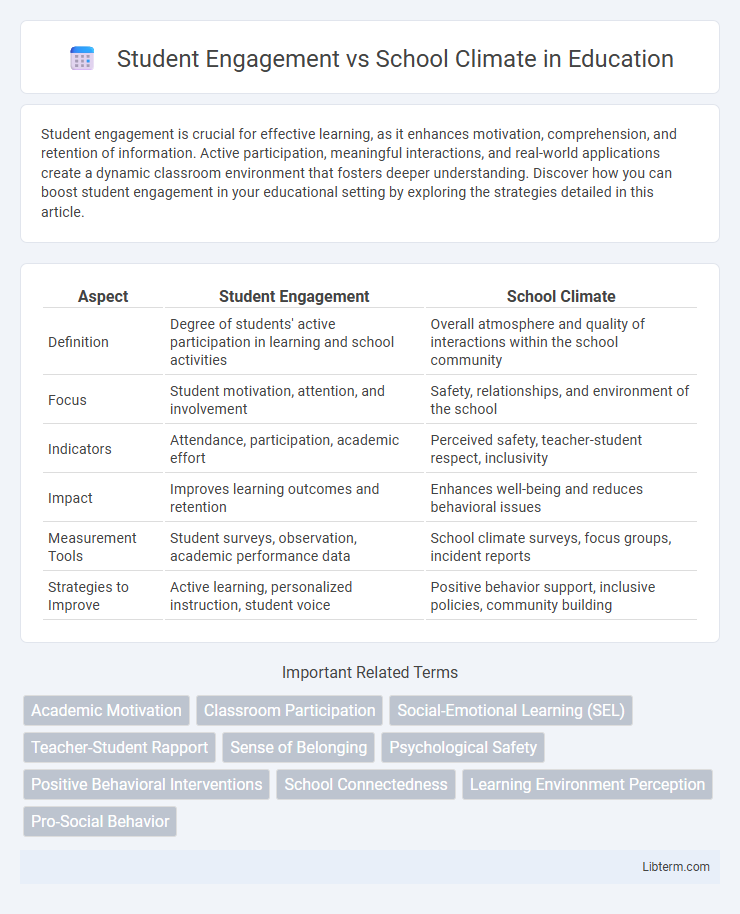Student engagement is crucial for effective learning, as it enhances motivation, comprehension, and retention of information. Active participation, meaningful interactions, and real-world applications create a dynamic classroom environment that fosters deeper understanding. Discover how you can boost student engagement in your educational setting by exploring the strategies detailed in this article.
Table of Comparison
| Aspect | Student Engagement | School Climate |
|---|---|---|
| Definition | Degree of students' active participation in learning and school activities | Overall atmosphere and quality of interactions within the school community |
| Focus | Student motivation, attention, and involvement | Safety, relationships, and environment of the school |
| Indicators | Attendance, participation, academic effort | Perceived safety, teacher-student respect, inclusivity |
| Impact | Improves learning outcomes and retention | Enhances well-being and reduces behavioral issues |
| Measurement Tools | Student surveys, observation, academic performance data | School climate surveys, focus groups, incident reports |
| Strategies to Improve | Active learning, personalized instruction, student voice | Positive behavior support, inclusive policies, community building |
Understanding Student Engagement
Student engagement encompasses behavioral, emotional, and cognitive involvement in learning activities, directly influencing academic achievement and motivation. Understanding student engagement requires analyzing factors like student-teacher relationships, classroom environment, and relevance of curriculum to students' interests. Effective engagement strategies improve school climate by fostering a supportive, inclusive atmosphere where students feel valued and motivated to participate.
Defining School Climate
School climate refers to the quality and character of school life, encompassing factors such as safety, teaching and learning practices, relationships, and the physical environment. It influences student engagement by shaping students' sense of belonging, motivation, and overall well-being within the educational setting. Positive school climate fosters supportive interactions among students, teachers, and staff, which directly enhances academic performance and emotional development.
Key Differences Between Student Engagement and School Climate
Student engagement refers to the level of participation, enthusiasm, and emotional investment students exhibit in learning activities, while school climate encompasses the overall atmosphere, safety, and relationships within the educational environment. Key differences include that student engagement is primarily individual and behavioral, focusing on academic motivation and involvement, whereas school climate is collective and contextual, reflecting the broader social and organizational culture. Understanding these distinctions helps educators implement targeted strategies to boost motivation and foster a positive, supportive school environment.
The Interconnection of Engagement and Climate
Student engagement and school climate are deeply interconnected, as a positive school climate fosters greater emotional, behavioral, and cognitive engagement among students. Research shows that supportive teacher-student relationships, safety, and inclusivity within the school environment directly impact students' motivation and active participation in learning. Enhancing school climate through policies and practices that promote respect and belonging leads to improved academic outcomes and reduced absenteeism, highlighting the cyclical nature between engagement and climate.
Impact of School Climate on Student Participation
Positive school climate significantly enhances student engagement by fostering a supportive and inclusive environment that encourages active participation in academic and extracurricular activities. Research shows that students in schools with a strong sense of safety, respect, and connectedness demonstrate higher levels of attendance, motivation, and collaboration. Improved school climate directly correlates with increased student participation, reducing behavioral issues and promoting academic success.
Strategies to Boost Student Engagement
Effective strategies to boost student engagement include incorporating interactive learning methods, such as project-based assignments and collaborative group work, which foster active participation and motivation. Creating a positive school climate through supportive teacher-student relationships and inclusivity enhances students' emotional connection to the learning environment. Utilizing technology tools and personalized learning plans further increases engagement by catering to diverse learning styles and interests.
Assessing School Climate in Educational Settings
Assessing school climate in educational settings involves measuring factors such as safety, relationships, teaching and learning practices, and the physical environment to determine their impact on student engagement. Tools like surveys, observation protocols, and focus groups provide comprehensive data on perceptions of support, respect, and connectedness within the school community. Understanding school climate helps identify strengths and areas for improvement, directly influencing strategies to enhance student motivation, attendance, and overall academic success.
Benefits of Positive Engagement and Climate
Positive student engagement enhances academic achievement, improves attendance rates, and fosters social-emotional development by creating a sense of belonging and motivation. A supportive school climate promotes safety, respect, and inclusivity, which reduces behavioral problems and increases teacher satisfaction and retention. Together, positive engagement and a healthy school climate contribute to improved student well-being and overall school success.
Challenges in Improving Engagement and Climate
Low student engagement often stems from lack of relevance in curriculum and insufficient teacher-student relationships, hindering academic motivation. School climate challenges include inconsistent disciplinary policies and inadequate support services, which contribute to feelings of unsafety and disengagement. Addressing these barriers requires targeted interventions that foster inclusivity and strengthen community trust within the educational environment.
Building a Supportive School Community
Fostering a supportive school community enhances student engagement by promoting positive relationships, trust, and collaboration among students, teachers, and staff. A positive school climate characterized by inclusivity, safety, and respect directly correlates with increased academic motivation and emotional well-being. Implementing programs that encourage peer support and active participation helps establish a nurturing environment where students feel valued and empowered.
Student Engagement Infographic

 libterm.com
libterm.com